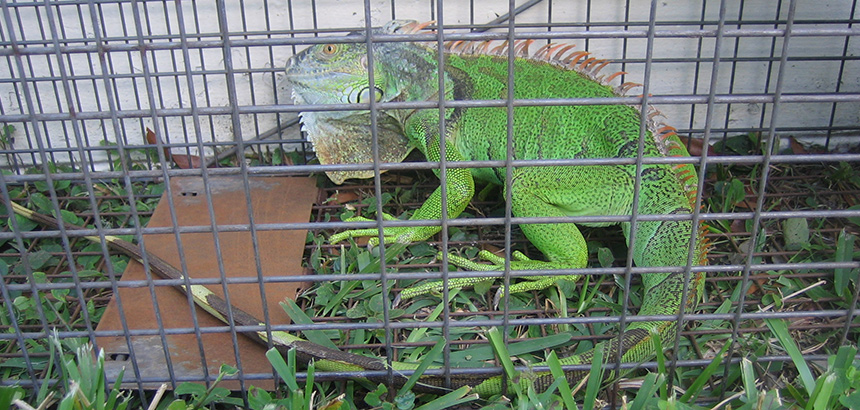- info@wildlifeanimalcontrol.com
Call us for help in your town
Wildlife Control Education
How to Get Rid of Iguanas
Most Iguana problems in the USA are in the state of Florida. In recent years, Florida has become something of a battleground between residents and green iguanas.
In fact, they have become such a big problem that people are being actively encouraged to kill them whenever possible.
Green iguanas are not native to Florida but have slowly invaded the state from Central and South America over at least the last six decades. According to scientists, green iguanas first came to Florida as pets. Since then they have thrived there, due to the state’s subtropical climate, huge human population, and few natural predators to stop them.

The green, or common, iguana is one of the largest lizards in the Americas, able to grow to an average of 6.5 feet long and an average weight of 11 lbs. They are also one of the most popular reptilian pets kept by households in the United States, although they are notoriously difficult to raise and are often released into the wild by their owners.
The herbivorous iguana is diurnal, meaning they are most active during the day, when they feed off of leaves, flowers, or fruits, and tend to live near bodies of water. Despite their large size, iguanas are surprisingly fast, able to reach speeds of up to 21 miles per hour on land. They also have very strong jaws and sharp teeth, whilst their sharp tails are one of their primary weapons.
Problems Iguanas Cause in Florida
Although they are a popular pet, in Florida they have become a serious problem. Unusually warm weather has contributed to an explosion in their reproduction rates, with pregnant female iguanas that can lay as many as 75 eggs a year. With their diet as herbivores, iguanas can cause considerable devastation to vegetation on both residential and commercial land.
But they are also capable of causing immense damage to buildings as well. Green iguanas will often dig burrows underneath sidewalks, the foundations of buildings, and even seawalls. Recently, in West Palm Beach, iguanas resulted in $1.8 million in emergency repairs to be carried out to a dam from the 1950s because their burrowing had caused water to begin seeping around its edges. In addition, iguana feces can transmit salmonella to humans if it contaminates water.
It is thought that one of the key contributors to the arrival of iguanas in Florida is its extensive network of man-made canals, which essentially gave iguanas a reliable and safe route through the state and plenty of hidden places to make their burrows.
Florida’s iguana problem has become so great that the state’s Fish and Wildlife Conservation Commission has had to intervene. In July 2019, it was announced that homeowners no longer needed a permit to kill any iguana on their property, with the FWC actively encouraging people to kill them whenever possible.
The FWC also made changes to Section 379.372 of the Florida Statutes to deal with them. This particular section deals with and regulates invasive reptiles not native to Florida that pose a particularly high risk. As of July 1, 2020, only facilities that kept iguanas for educational, research, eradication, or control purposes are allowed to possess, import, or breed them.
In response, there are many petitions gaining thousands of signatures that want to stop the iguanas from being actively killed as it is regarded as inhumane. But the FWC claims that it only promotes killing them as a last resort, with Florida Wildlife Commissioner Rodney Barreto urging homeowners to seek professional assistance only if they themselves cannot humanely remove iguanas from their property.
How to Get Rid of Them
Aside from legally killing them, there are other humane ways of removing iguanas from your property, most of which revolve around the concept of control and prevention. Many websites claim that spraying iguanas with water will deter them, but iguanas actively seek water sources such as swimming pools, so spraying them with water is likely to have the opposite effect. Trapping is also not encouraged, as it is more important to make your home as unwelcoming for them as possible.
Cover Water Sources
Instead, any water sources around your property, like pools or water bowls for other pets, should be covered whenever possible to stop iguanas from getting to them. The same goes for food, as without a reliable source of food iguanas are unlikely to stick around or even visit your property.
Remove Food Sources
As already stated, iguanas are herbivores, so chances are whatever they are eating will be in your garden or yard. To combat this, be sure to diligently clear the floor of any fruit that may have fallen from trees and create barriers like sheet metal around any fruit trees that will be strong enough to deter them.
Re-landscape
Another natural method is to re-landscape your garden and remove anything that might be attracting iguanas, which unfortunately applies to most fruits and vegetables and even decorative tropical plants like hibiscus or bougainvillea. You could instead consider fencing these off, but iguanas are adept at burrowing so you need to be sure whatever material you use goes deep enough and can withstand their sharp claws.
If your property has a lot of vegetation surrounding it, like thickets or bushes, you could also clear these or trim them down because iguanas often tend to burrow into these and use them as protection. Also, if you do spot any burrows, be sure to fill them in quickly.
Commercial Repellents
Some commercial repellents are available from a number of suppliers that could also be used to deter iguanas from your property, spraying them where they frequently go such as pools or around certain plants. You could also use sounds to scare them away as iguanas are sensitive to loud and sudden noises, such as wind chimes or sound-emitting devices.

















